2018 PEUGEOT EXPERT belt
[x] Cancel search: beltPage 107 of 416
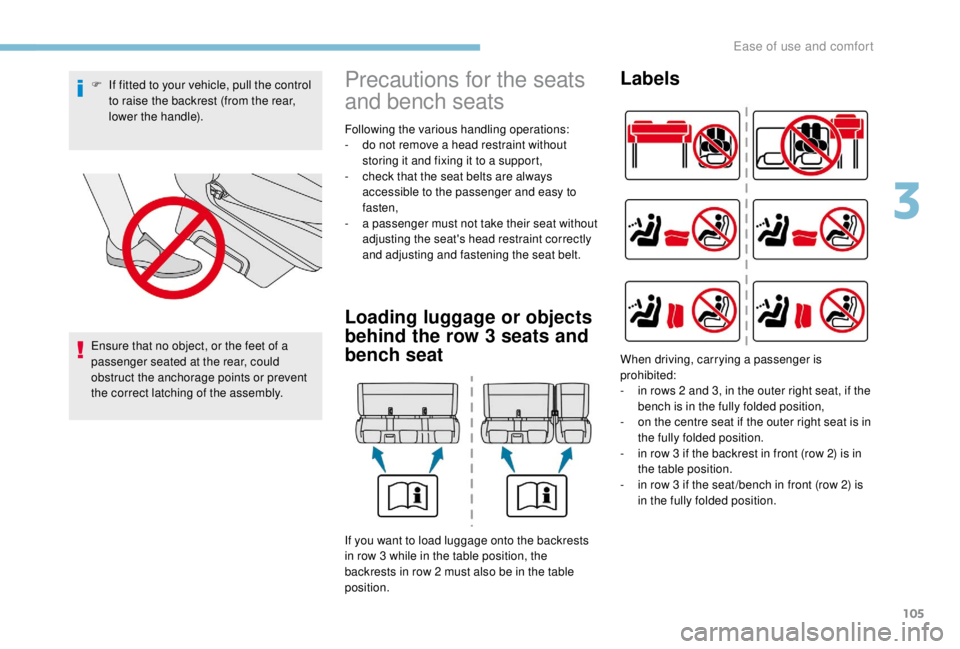
105
F If fitted to your vehicle, pull the control to raise the backrest (from the rear,
lower the handle).
Ensure that no object, or the feet of a
passenger seated at the rear, could
obstruct the anchorage points or prevent
the correct latching of the assembly.Precautions for the seats
and bench seats
Following the various handling operations:
- d o not remove a head restraint without
storing it and fixing it to a support,
-
c
heck that the seat belts are always
accessible to the passenger and easy to
fasten,
-
a p
assenger must not take their seat without
adjusting the seat's head restraint correctly
and adjusting and fastening the seat belt.
Loading luggage or objects
behind the row 3 seats and
bench seat
If you want to load luggage onto the backrests
in row 3
while in the table position, the
backrests in row 2
must also be in the table
position.
Labels
When driving, carrying a passenger is
prohibited:
-
i
n rows 2 and 3, in the outer right seat, if the
bench is in the fully folded position,
-
o
n the centre seat if the outer right seat is in
the fully folded position.
-
i
n row 3 if the backrest in front (row 2) is in
the table position.
-
i
n row 3 if the seat /bench in front (row 2) is
in the fully folded position.
3
Ease of use and comfort
Page 108 of 416
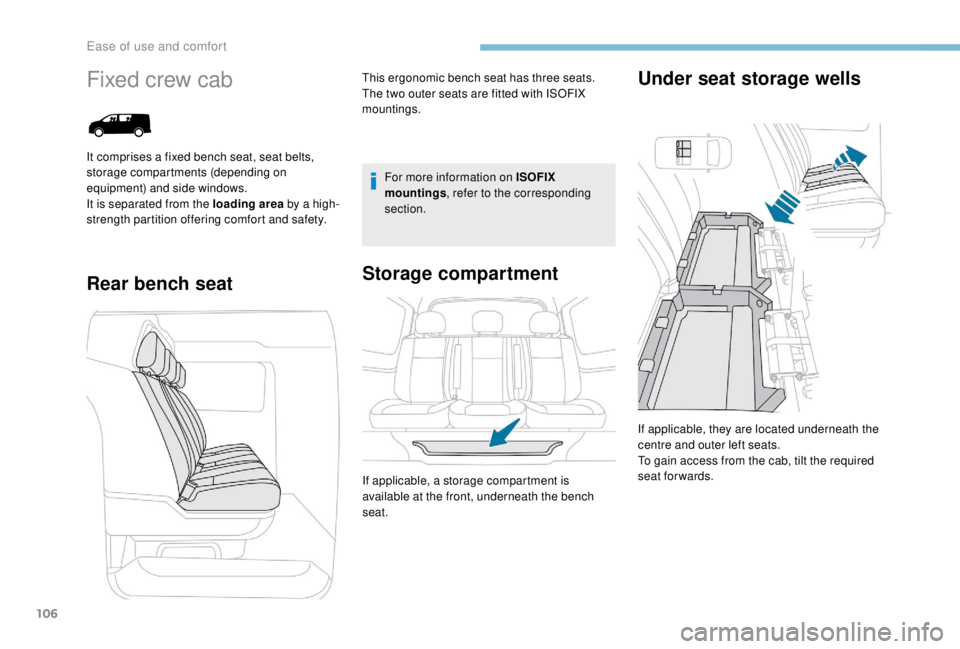
106
Fixed crew cab
Rear bench seatStorage compartment Under seat storage wells
For more information on ISOFIX
mountings
, refer to the corresponding
section.
If applicable, they are located underneath the
centre and outer left seats.
To gain access from the cab, tilt the required
seat forwards.
This ergonomic bench seat has three seats.
The two outer seats are fitted with ISOFIX
mountings.
If applicable, a storage compartment is
available at the front, underneath the bench
seat.
It comprises a fixed bench seat, seat belts,
storage compartments (depending on
equipment) and side windows.
It is separated from the loading area
by a high-
strength partition offering comfort and safety.
Ease of use and comfort
Page 109 of 416
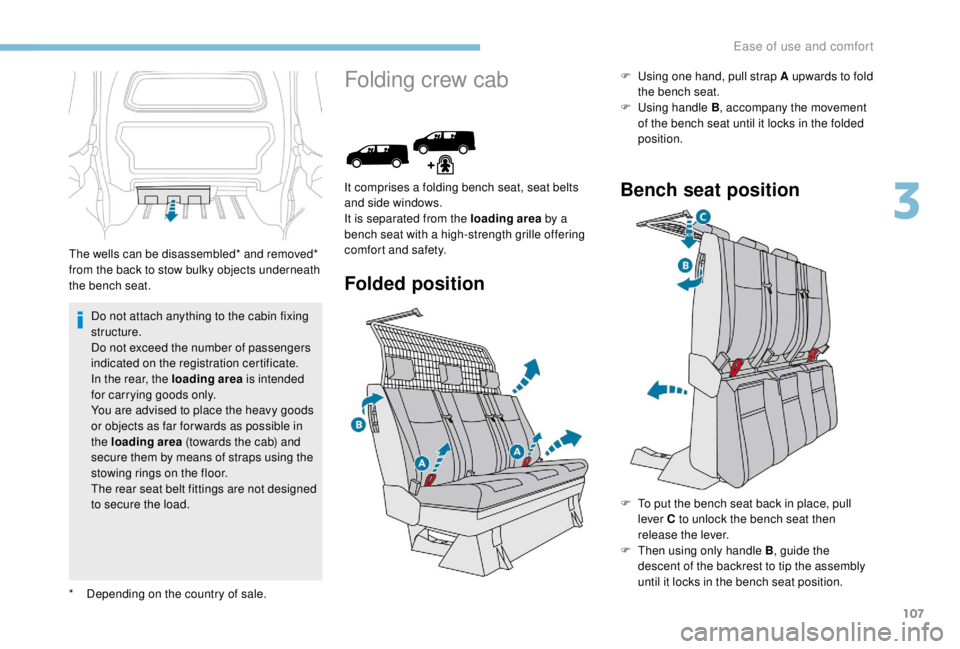
107
Do not attach anything to the cabin fixing
structure.
Do not exceed the number of passengers
indicated on the registration certificate.
In the rear, the loading area is intended
for carrying goods only.
You are advised to place the heavy goods
or objects as far for wards as possible in
the loading area (towards the cab) and
secure them by means of straps using the
stowing rings on the floor.
The rear seat belt fittings are not designed
to secure the load.
The wells can be disassembled* and removed*
from the back to stow bulky objects underneath
the bench seat.
*
D
epending on the country of sale.
Folding crew cab
Folded position
It comprises a folding bench seat, seat belts
and side windows.
It is separated from the loading area by a
bench seat with a high-strength grille offering
comfort and safety. F
Us
ing one hand, pull strap A upwards to fold
the bench seat.
F
Us
ing handle B
, accompany the movement
of the bench seat until it locks in the folded
position.Bench seat position
F To put the bench seat back in place, pull lever C to unlock the bench seat then
release the lever.
F
T
hen using only handle B , guide the
descent of the backrest to tip the assembly
until it locks in the bench seat position.
3
Ease of use and comfort
Page 110 of 416
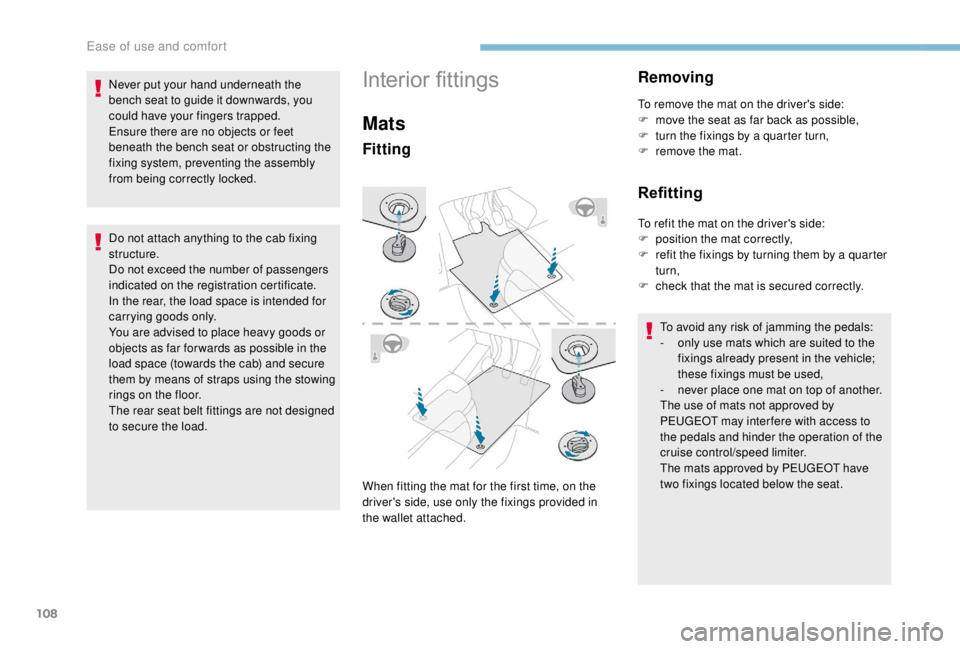
108
Do not attach anything to the cab fixing
structure.
Do not exceed the number of passengers
indicated on the registration certificate.
In the rear, the load space is intended for
carrying goods only.
You are advised to place heavy goods or
objects as far for wards as possible in the
load space (towards the cab) and secure
them by means of straps using the stowing
rings on the floor.
The rear seat belt fittings are not designed
to secure the load.
Interior fittings
Mats
Fitting
When fitting the mat for the first time, on the
driver's side, use only the fixings provided in
the wallet attached.
Removing
To remove the mat on the driver's side:
F m ove the seat as far back as possible,
F
t
urn the fixings by a quarter turn,
F
r
emove the mat.
Refitting
To refit the mat on the driver's side:
F p osition the mat correctly,
F
r
efit the fixings by turning them by a quarter
turn,
F
c
heck that the mat is secured correctly.
To avoid any risk of jamming the pedals:
-
o
nly use mats which are suited to the
fixings already present in the vehicle;
these fixings must be used,
-
n
ever place one mat on top of another.
The use of mats not approved by
PEUGEOT may inter fere with access to
the pedals and hinder the operation of the
cruise control/speed limiter.
The mats approved by PEUGEOT have
two fixings located below the seat.
Never put your hand underneath the
bench seat to guide it downwards, you
could have your fingers trapped.
Ensure there are no objects or feet
beneath the bench seat or obstructing the
fixing system, preventing the assembly
from being correctly locked.
Ease of use and comfort
Page 152 of 416
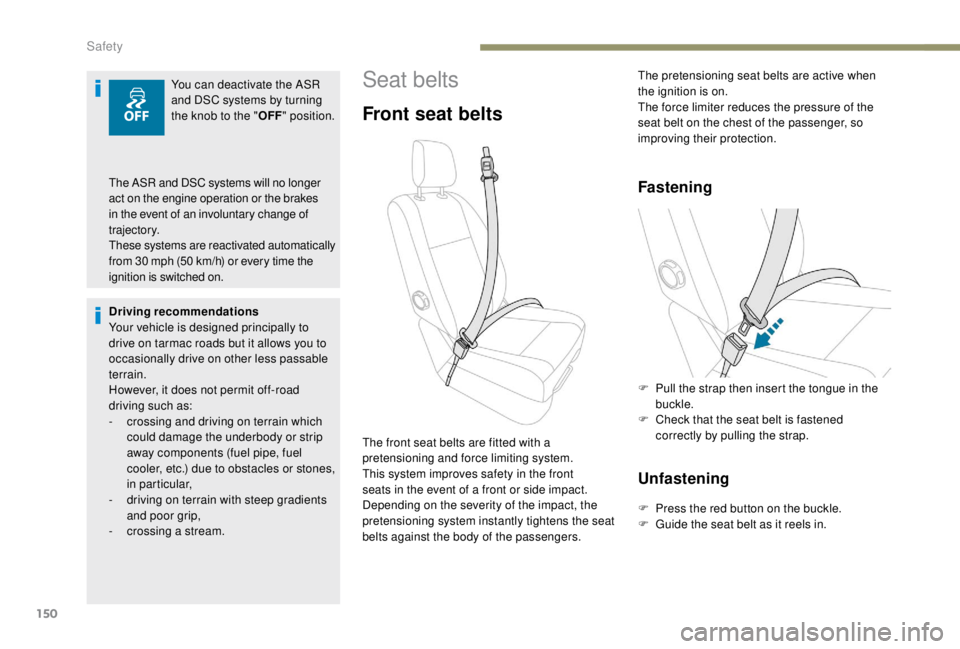
150
Seat belts
Front seat belts
Fastening
Unfastening
F Press the red button on the buckle.
F G uide the seat belt as it reels in.
The front seat belts are fitted with a
pretensioning and force limiting system.
This system improves safety in the front
seats in the event of a front or side impact.
Depending on the severity of the impact, the
pretensioning system instantly tightens the seat
belts against the body of the passengers. The pretensioning seat belts are active when
the ignition is on.
The force limiter reduces the pressure of the
seat belt on the chest of the passenger, so
improving their protection.
F
P
ull the strap then insert the tongue in the
buckle.
F
C
heck that the seat belt is fastened
correctly by pulling the strap.
You can deactivate the ASR
and DSC systems by turning
the knob to the "
OFF" position.
The ASR and DSC systems will no longer
act on the engine operation or the brakes
in the event of an involuntary change of
trajectory.
These systems are reactivated automatically
from 30
mph (50
km/h) or every time the
ignition is switched on.
Driving recommendations
Your vehicle is designed principally to
drive on tarmac roads but it allows you to
occasionally drive on other less passable
terrain.
However, it does not permit off-road
driving such as:
-
c
rossing and driving on terrain which
could damage the underbody or strip
away components (fuel pipe, fuel
cooler, etc.) due to obstacles or stones,
in particular,
-
d
riving on terrain with steep gradients
and poor grip,
-
c
rossing a stream.
Safety
Page 153 of 416
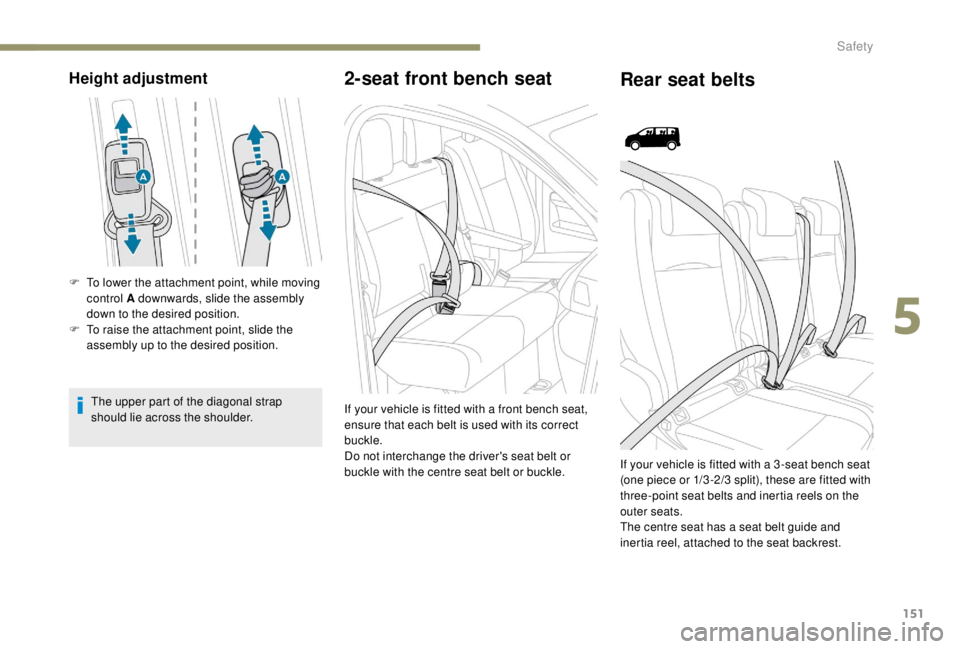
151
Height adjustment
F To lower the attachment point, while moving control A downwards, slide the assembly
down to the desired position.
F
T
o raise the attachment point, slide the
assembly up to the desired position.
The upper part of the diagonal strap
should lie across the shoulder.
2-seat front bench seat
If your vehicle is fitted with a front bench seat,
ensure that each belt is used with its correct
buckle.
Do not interchange the driver's seat belt or
buckle with the centre seat belt or buckle.
Rear seat belts
If your vehicle is fitted with a 3 -seat bench seat
(one piece or 1/3 -2/3 split), these are fitted with
three-point seat belts and inertia reels on the
outer seats.
The centre seat has a seat belt guide and
inertia reel, attached to the seat backrest.
5
Safety
Page 154 of 416

152
For rows 2 and 3, fit each seat belt to its
c orrect buckle.
Do not interchange the belts or buckles for
the outer seats with the belt or buckle for
the centre seat.
When folding the outer seats or placing
a backrest in the table position, avoid
trapping the belt for the centre seat.
After folding a rear seat or bench seat,
ensure that the seat belt has reeled
in correctly and the buckle is ready to
receive the belt tongue.
When handling the outer seats (removing
or refitting) or for access to row 3, avoid
trapping the centre belt.
The seat belt reels for the outer seats in row
2
have force limiters.
The seats in row 3 have three-point seat belts
with inertia reels.
Seat belt warning lamps
With individual front seats
1. Front seat belts not fastened/unfastened
warning lamp.
2. Left seat belt not fastened/unfastened
warning lamp.
3. Right seat belt not fastened/unfastened
warning lamp.
On switching on the ignition, a warning lamp
comes on if the corresponding seat belt is not
fastened or is unfastened. From approximately 12
mph (20 km/h),
the warning lamp(s) flash for two minutes,
associated with an audible signal. Beyond
these two minutes, the warning lamps
remain on if the driver or front passenger
do not fasten their seat belt(s). With 2-seat front bench seat (and the
driver's seat)
On switching on the ignition, a warning lamp
comes on if the corresponding seat belt is not
fastened or is unfastened. A.
Front seat belts not fastened/unfastened
warning lamp.
B. Left seat belt not fastened/unfastened
warning lamp.
C. Centre seat belt unfastened warning lamp
in the instrument panel.
D. Right seat belt unfastened warning lamp.
Safety
Page 155 of 416
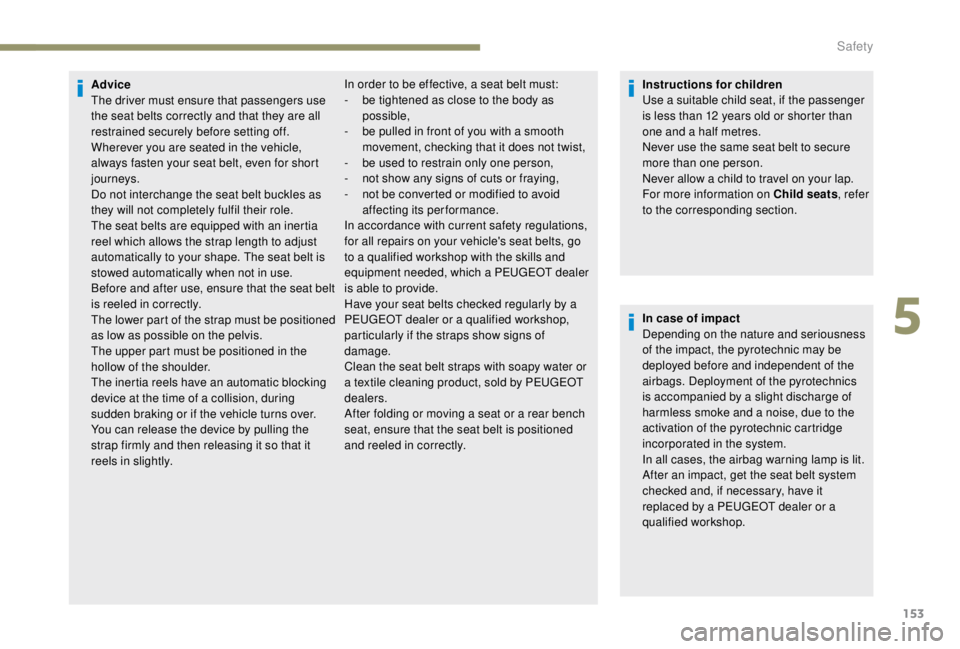
153
Advice
The driver must ensure that passengers use
the seat belts correctly and that they are all
restrained securely before setting off.
Wherever you are seated in the vehicle,
always fasten your seat belt, even for short
journeys.
Do not interchange the seat belt buckles as
they will not completely fulfil their role.
The seat belts are equipped with an inertia
reel which allows the strap length to adjust
automatically to your shape. The seat belt is
stowed automatically when not in use.
Before and after use, ensure that the seat belt
is reeled in correctly.
The lower part of the strap must be positioned
as low as possible on the pelvis.
The upper part must be positioned in the
hollow of the shoulder.
The inertia reels have an automatic blocking
device at the time of a collision, during
sudden braking or if the vehicle turns over.
You can release the device by pulling the
strap firmly and then releasing it so that it
reels in slightly.Instructions for children
Use a suitable child seat, if the passenger
is less than 12
years old or shorter than
one and a half metres.
Never use the same seat belt to secure
more than one person.
Never allow a child to travel on your lap.
For more information on Child seats , refer
to the corresponding section.
In case of impact
Depending on the nature and seriousness
of the impact, the pyrotechnic may be
deployed before and independent of the
airbags. Deployment of the pyrotechnics
is accompanied by a slight discharge of
harmless smoke and a noise, due to the
activation of the pyrotechnic cartridge
incorporated in the system.
In all cases, the airbag warning lamp is lit.
After an impact, get the seat belt system
checked and, if necessary, have it
replaced by a PEUGEOT dealer or a
qualified workshop.
In order to be effective, a seat belt must:
-
b e tightened as close to the body as
possible,
-
b
e pulled in front of you with a smooth
movement, checking that it does not twist,
-
b
e used to restrain only one person,
-
n
ot show any signs of cuts or fraying,
-
n
ot be converted or modified to avoid
affecting its performance.
In accordance with current safety regulations,
for all repairs on your vehicle's seat belts, go
to a qualified workshop with the skills and
equipment needed, which a PEUGEOT dealer
is able to provide.
Have your seat belts checked regularly by a
PEUGEOT dealer or a qualified workshop,
particularly if the straps show signs of
damage.
Clean the seat belt straps with soapy water or
a textile cleaning product, sold by PEUGEOT
dealers.
After folding or moving a seat or a rear bench
seat, ensure that the seat belt is positioned
and reeled in correctly.
5
Safety